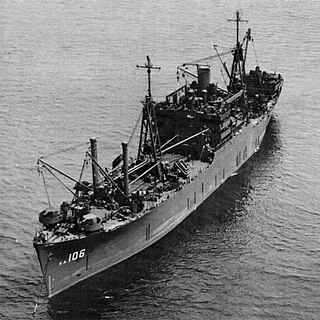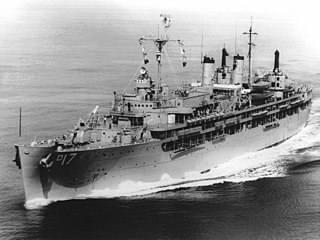
USS Rainier (AE-5), the second US Navy vessel named after Mount Rainier, was laid down on 14 May 1940 by the Tampa Shipbuilding Co., Tampa, Fla., as Rainbow ; launched 1 March 1941; sponsored by Mrs. Robert E. Anderson; transferred to the US Navy on 16 April 1941; converted for use as an ammunition auxiliary; and commissioned as Rainier (AE-5) on 21 December 1941 at Norfolk, Va..

The fourth USS Vesuvius (AE-15) was laid down under a Maritime Commission contract by the North Carolina Shipbuilding Company, Wilmington, N.C.; launched on 26 May 1944; acquired by the United States Navy on 4 July 1944; and commissioned on 16 January 1945.

USS Guadalupe (AO-32), a Cimarron-class fleet replenishment oiler that served in the United States Navy, it was named for the Guadalupe River in Texas.

USS Union (AKA-106) was a Tolland-class attack cargo ship of the United States Navy, the fourth ship with this name, and served as a commissioned ship for 25 years and 1 month.

USS Platte (AO-24) was a Cimarron-class oiler serving with the United States Navy, named for the 1836 Platte Purchase that included the Platte Rivers in Iowa, Missouri and Nebraska. Her memorial in Platte County, Missouri honors all four rivers that share the name recorded by Lewis and Clark in 1803.

USS Tulare (AKA-112/LKA-112) was a Tulare-class attack cargo ship in service with the United States Navy from 1956 to 1986. She was sold for scrap in 2011.

USS Warrick (AKA-89) was an Andromeda-class attack cargo ship in service with the United States Navy from 1944 to 1957. She was sunk as a target in 1971.

USS Virgo (AKA-20) was an Andromeda class attack cargo ship of the United States Navy, named after the constellation Virgo. She was later converted to an ammunition ship and redesignated as (AE-30). She served as a commissioned ship for 22 years and 4 months.

USS Piedmont (AD–17) was a Dixie-class destroyer tender built during World War II for the United States Navy. Her task was to service destroyers in, or near, battle areas and to keep them fit for duty. She served in the Pacific Ocean during World War II, the Cold War, the Korean War, and the Vietnam War. For her work in battle areas, the ship was awarded four battle stars for her Korean War efforts and one for Vietnam War service.

USS Hector (AR-7) was a repair ship that served in the United States Navy from 1944 to 1987 and as PNS Moawin in the Pakistan Navy from 1989 to 1994.

USS Sedgwick County (LST-1123) was an LST-542-class tank landing ship in the United States Navy. Unlike many of her class, which received only numbers and were disposed of after World War II, she survived long enough to be named. On 1 July 1955, all LSTs still in commission were named for US counties or parishes; LST-1123 was given the name Sedgwick County, after counties in Colorado and Kansas.

USS Caliente (AO-53) was a Cimarron-class fleet oiler built during World War II for the U.S. Navy. During her career in the Pacific Ocean, Caliente participated in World War II, the Korean War, and the Vietnam War. She was highly decorated for fulfilling her dangerous mission of carrying fuel into battle areas. She received ten battle stars for World War II, four for the Korean War and eight campaign stars for the Vietnam War.

USS Taluga (AO-62) was a Cimarron-class fleet oiler acquired by the U.S. Navy during World War II. She served her country primarily in the Pacific Ocean Theatre of Operations, and provided petroleum products where needed to combat ships. For performing this dangerous task in combat areas, she was awarded four battle stars during World War II, four during the Korean War, and six campaign stars during the Vietnam War.

USS Tolovana (AO-64) was a Cimarron-class fleet oiler acquired by the U.S. Navy during World War II. She served her country primarily in the Pacific Ocean Theatre of Operations, and provided petroleum products where needed to combat ships. For performing this dangerous task in combat areas, she was awarded one battle star during World War II, two during the Korean War, and thirteen campaign stars and the Navy Unit Commendation during the Vietnam War.

USS Silverstein (DE-534) was a John C. Butler-class destroyer escort in service with the United States Navy from 1944 to 1947 and from 1951 to 1958. She was sold for scrapping in 1973.

USS Ashtabula (AO-51) was a Cimarron-class fleet oiler of the United States Navy in service from 1943 to 1991. She survived three wars and was awarded eight battle stars for World War II service, four battle stars for Korean War service, and eight campaign stars for Vietnam War service. In the mid-1960s Ashtabula became the lead ship of her class, when she and seven other Cimarron-class oilers were lengthened ("jumboized"). She has been the only U.S. Navy ship to bear the name Ashtabula, after the City of Ashtabula which was named after the Ashtabula River in northeast Ohio.

USS Castor (AKS-1) was a Castor-class general stores issue ship commissioned by the U.S. Navy for service in World War II. She was responsible for delivering and disbursing goods and equipment to locations in the war zone.

USS Vega (AF-59) was a Rigel-class stores ship acquired by the U.S. Navy. Her task was to carry stores, refrigerated items, and equipment to ships in the fleet, and to remote stations and staging areas. She served during the entire Vietnam War and returned home with numerous battle stars and commendations.

USS St. Clair County (LST-1096) was a LST-542-class tank landing ship built for the United States Navy in World War II. Like most of the ships of her class she was originally known only by her designation, USS LST-1096, and, like all remaining LSTs, was renamed on 1 July 1955. She was named for counties in Alabama, Illinois, Michigan, and Missouri.

USS Woodpecker (AMS/MSC-209) was a Bluebird-class minesweeper of the United States Navy, that saw service during the Vietnam War, and was later sold to the Republic of Fiji where she served as HMFS Kikau (MSC-204).




















